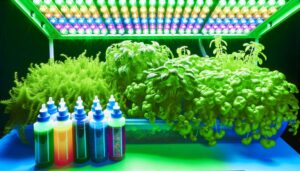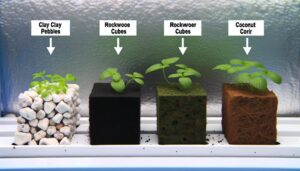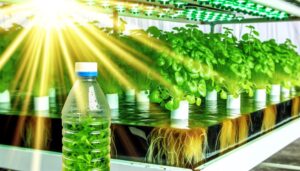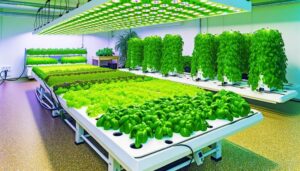How to Use Dwc Hydroponics
Mastering Deep Water Culture (DWC) hydroponics involves suspending plant roots in nutrient-rich, oxygenated water. Start by selecting a durable reservoir and setting up a high-output air pump with air stones for oxygenation.
Use net pots filled with an inert, porous growing medium like hydroton to stabilize plants. Maintain the nutrient solution's pH between 5.5-6.5 using accurate pH meters and adjustments.
Regularly monitor nutrient concentrations with electrical conductivity meters and guarantee consistent oxygen supply. Cleaning and sterilization practices are essential to prevent root diseases, promoting vigorous plant growth.
Continue on to explore in-depth techniques for optimizing DWC systems.
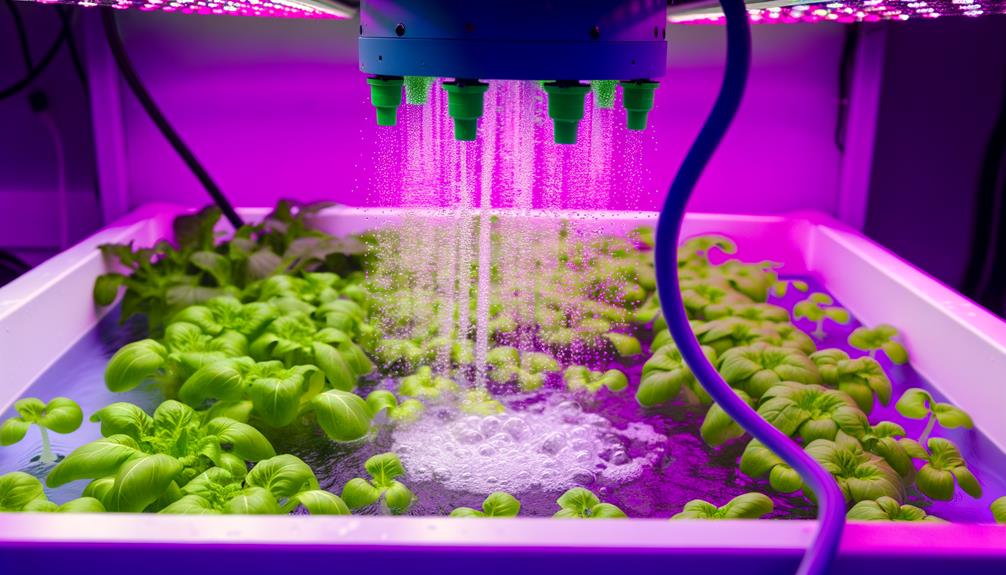
Key Takeaways
- Suspend plant roots in an oxygenated, nutrient-rich water reservoir using net pots and grow media.
- Regularly monitor and adjust pH levels to maintain the ideal range of 5.5-6.5.
- Use air pumps and air stones to ensure adequate oxygen supply and prevent root suffocation.
- Prepare and mix nutrient solutions accurately, following manufacturer's guidelines and measuring with precision.
Understanding DWC Basics
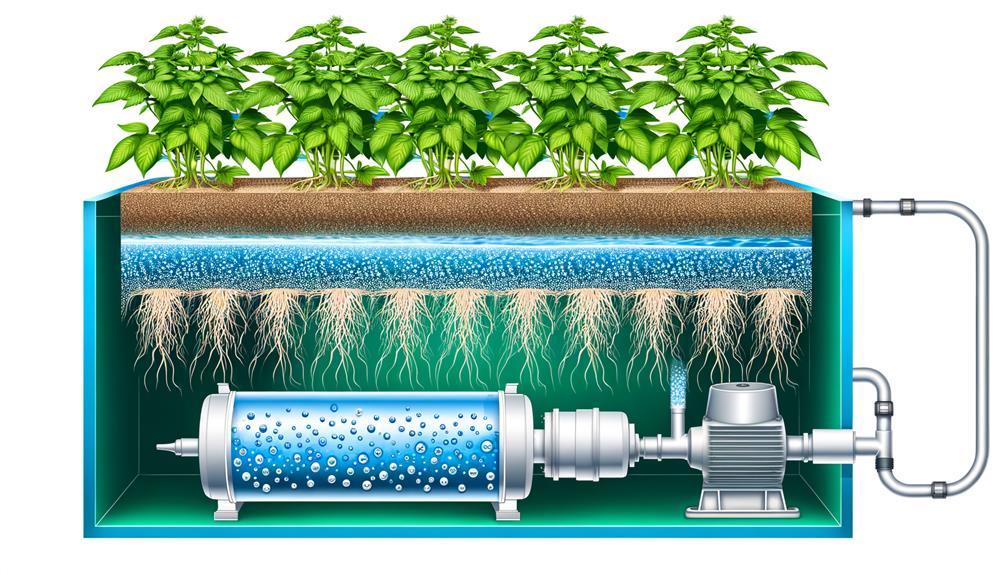
Deep Water Culture (DWC) hydroponics is a method where plant roots are suspended in a nutrient-rich, oxygenated water solution. This approach provides an efficient and effective way to grow plants. By immersing the roots directly into the water reservoir, plants receive constant access to essential nutrients and oxygen, promoting rapid growth and robust health.
Key components of DWC include a water reservoir, air pump, air stones, and net pots. The air pump continuously supplies oxygen to the water via air stones, preventing root suffocation and fostering an ideal growth environment.
Maintaining proper nutrient balance and pH levels is critical for plant health. Regularly monitor these parameters using pH and electrical conductivity (EC) meters to verify they remain within ideal ranges for specific plant types.
Choosing the Right Equipment
When selecting equipment for DWC hydroponics, it is vital to focus on essential components such as the reservoir, air pump, air stones, and net pots. These components work together to ensure proper oxygenation and nutrient circulation for healthy plant growth. Additionally, growers interested in vertical systems may research how to use a hydroponic tower to maximize space efficiency. Understanding the role of each component will help create an optimal environment for thriving plants.
Ensuring the quality of these supplies will directly impact system efficiency and plant health.
Prioritize durable materials and reputable brands to establish a reliable and effective hydroponic setup.
Essential DWC Components
Selecting the appropriate equipment for your Deep Water Culture (DWC) system is vital to guaranteeing ideal plant growth and system efficiency.
Key components include a reservoir, typically a food-grade plastic container, which holds the nutrient solution. An air pump coupled with air stones is critical for oxygenating the water, preventing root rot and promoting vigorous growth.
Net pots support the plants and allow roots to access the nutrient-rich solution. Consider using hydroponic grow media like clay pebbles to stabilize plants within net pots.
Additionally, a reliable pH meter and EC (Electrical Conductivity) meter are indispensable tools for monitoring nutrient concentration and maintaining peak conditions.
Light sources, such as LED grow lights, guarantee adequate photosynthesis.
Selecting Quality Supplies
Investing in high-quality supplies is essential for the best performance and longevity of your DWC hydroponics system. Selecting the right equipment involves evaluating various factors like durability, efficiency, and compatibility. Focus on critical components such as air pumps, air stones, and net pots. Below is a concise guide to help you choose quality supplies:
| Component | Recommended Features | Benefits |
|---|---|---|
| Air Pump | High output, low noise | Guarantees ideal oxygenation |
| Air Stone | Fine bubbles, durable material | Enhances nutrient absorption |
| Reservoir | Food-grade plastic, opaque | Prevents algae growth |
| Net Pots | Sturdy, appropriately sized | Supports plant stability |
Setting Up the Reservoir
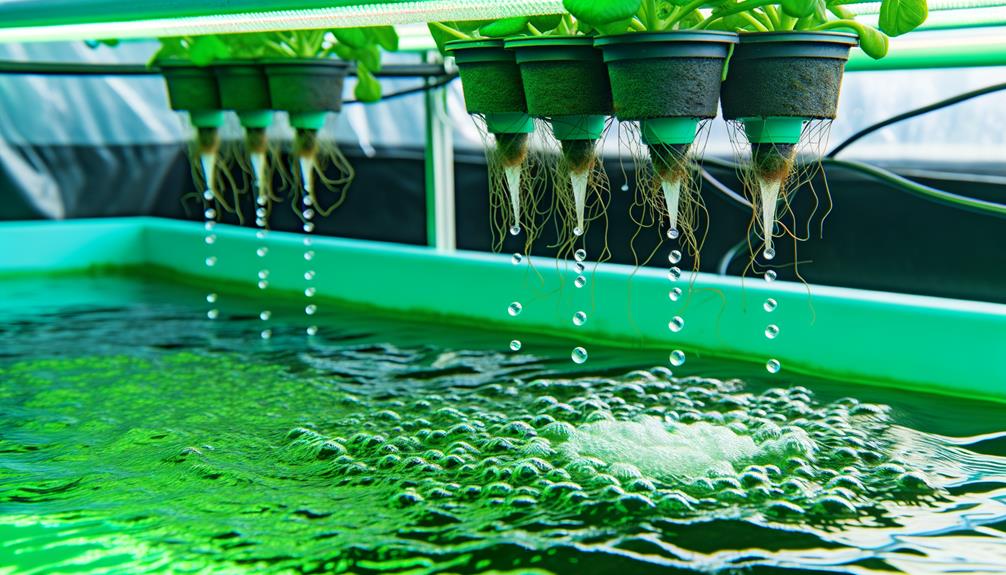
To set up the reservoir for your Deep Water Culture (DWC) hydroponic system, start by selecting a high-quality, durable container that can hold an adequate volume of nutrient solution.
Verify the container is opaque to prevent light from encouraging algae growth.
Next, follow these steps:
- Install an air pump and air stones: These will oxygenate the water, vital for root health. Place the air stones at the bottom and connect them to the air pump via air tubing.
- Add water and nutrients: Fill the reservoir with water and mix in hydroponic nutrients according to the manufacturer's guidelines. Confirm the solution is well-mixed.
- Check and adjust pH levels: Use a pH meter to adjust the solution to the ideal pH range of 5.5-6.5 for most plants.
This setup will guarantee your plants receive essential nutrients and oxygen.
Preparing the Grow Medium
To prepare the grow medium for DWC hydroponics, first select an appropriate medium such as hydroton, rockwool, or perlite, based on the specific needs of your plants.
Next, sterilize the chosen medium using a solution of hydrogen peroxide or a mild bleach mixture to eliminate any potential contaminants.
Choosing the Medium
Selecting the appropriate grow medium is pivotal to the success of your DWC hydroponic system, as it provides essential support and aeration for the plant roots. The chosen medium must be inert, meaning it does not affect the pH or nutrient balance.
Consider the following options:
- Hydroton (Expanded Clay Pellets): These clay pellets offer excellent aeration and drainage, and their round shape prevents root compaction.
- Rockwool: This medium provides a stable structure and retains moisture efficiently, but requires careful pH management.
- Coco Coir: Made from coconut husks, coco coir retains moisture well and promotes healthy root growth, though it may require periodic flushing to remove salts.
Choose a medium that aligns with your system's requirements and maintenance capabilities.
Sterilizing the Materials
Once you have selected the appropriate grow medium, it is essential to sterilize all materials to prevent contamination and guarantee a healthy growing environment for your plants.
Begin by thoroughly rinsing the grow medium with distilled water to remove any residual dust or debris.
Prepare a sterilizing solution by mixing one part hydrogen peroxide (3%) with ten parts water.
Submerge the grow medium in this solution for 30 minutes to eradicate any potential pathogens.
After soaking, drain the solution and rinse the medium again with distilled water to remove any residual hydrogen peroxide.
Allow the medium to air dry completely before use.
This meticulous sterilization process is vital to maintaining a sterile environment, promoting ideal plant health and growth in a DWC system.
Ensuring Proper Drainage
Ensuring proper drainage in the grow medium is crucial for preventing waterlogging and promoting ideal root development in a DWC hydroponic system. Proper drainage guarantees that roots receive adequate oxygen and nutrients, preventing root rot and other issues.
To achieve optimal drainage, follow these steps:
- Select the Right Medium: Use inert, porous materials like hydroton clay pebbles, which facilitate excellent drainage and aeration.
- Rinse Thoroughly: Wash the grow medium to remove any dust or debris, which can clog the system and impede water flow.
- Layering Technique: Create a base layer of larger particles to enhance drainage, followed by smaller particles to support the plant structure.
These practices will maintain a balanced growth environment, safeguarding the health and vitality of your hydroponic plants.
Planting in DWC
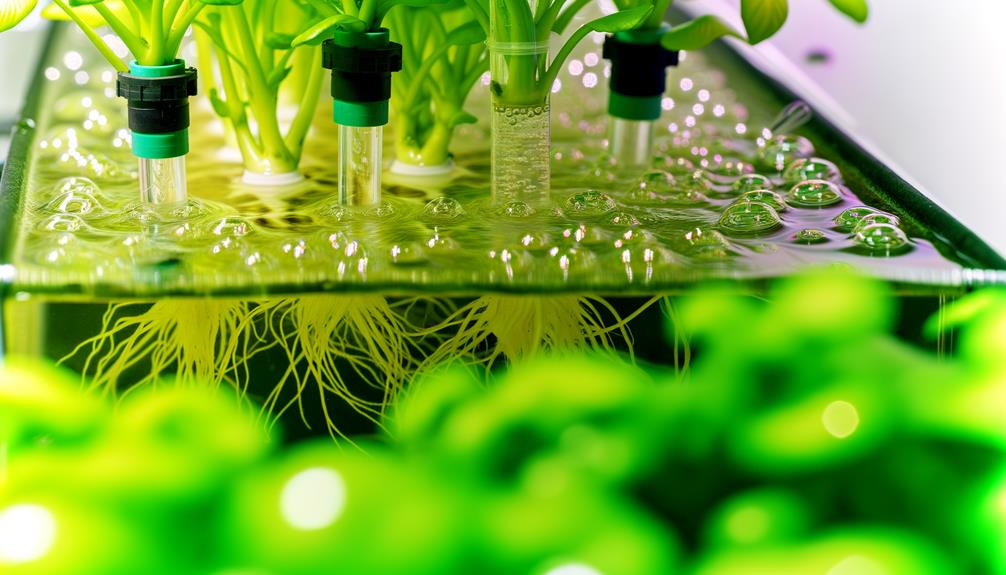
To successfully plant in a Deep Water Culture (DWC) system, start by carefully positioning the seedlings within the net pots, guaranteeing that the roots have adequate exposure to the nutrient-rich solution.
Fill the net pots with a suitable growing medium, such as hydroton or rockwool, to support the seedlings. Gently insert the seedlings so that the roots extend through the bottom of the net pot.
Confirm that the roots are in direct contact with the nutrient solution to facilitate ideal nutrient uptake. Maintain a consistent water level, typically 1-2 inches above the base of the net pot, to keep the roots submerged.
Monitor root development regularly and adjust the water level as necessary to promote healthy growth.
Mixing Nutrient Solutions
Accurately mixing nutrient solutions is essential for maintaining the ideal growth conditions in a Deep Water Culture (DWC) system. Precision in this process guarantees maximum nutrient uptake and plant health.
To achieve this, follow these steps:
- Measure Nutrients: Utilize a digital scale to weigh each component accurately. Refer to the specific nutrient manufacturer's guidelines for proportions.
- Dissolve Nutrients: In a clean reservoir, dissolve each nutrient in water separately before combining. This prevents chemical reactions that may render nutrients unavailable.
- Mix Thoroughly: Use an air pump or a dedicated mixing pump to guarantee uniform distribution of nutrients within the solution.
Implementing these steps with diligence will promote robust plant growth and enhance overall system performance.
Maintaining Ph Levels
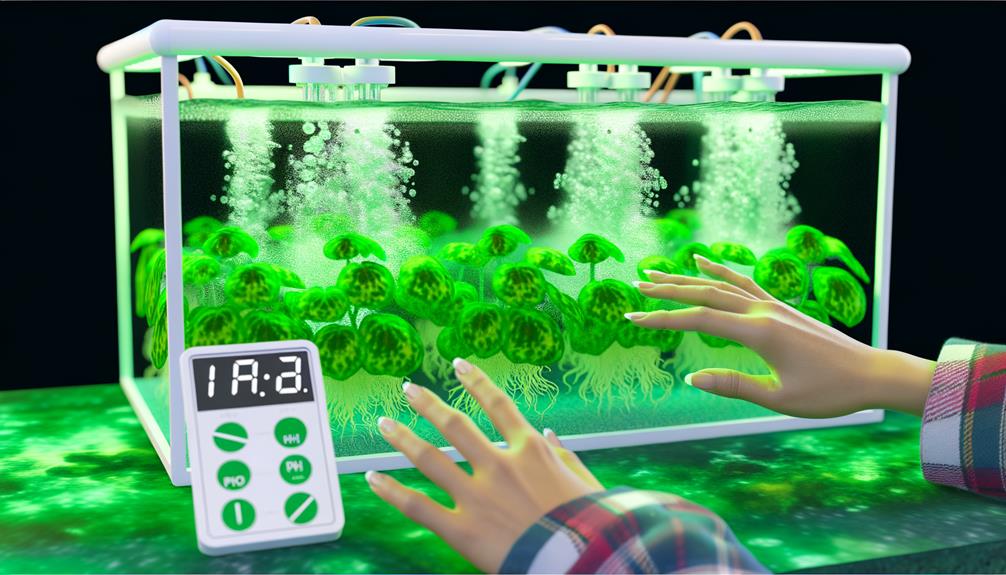
Maintaining precise pH levels in your nutrient solution is fundamental to enhancing nutrient availability and ensuring plant health in a DWC hydroponics system. The ideal pH range for most hydroponic plants is 5.5 to 6.5.
Regularly test the pH using a reliable digital pH meter, calibrating it frequently for accuracy. If the pH deviates from the ideal range, adjust it using pH up or pH down solutions. Add these in small increments, allowing the solution to mix thoroughly before retesting.
Consistent monitoring, at least every couple of days, is essential as even minor fluctuations can impact nutrient uptake. Record pH readings to track trends, ensuring a stable growing environment for your plants.
Oxygenating the Water
Proper oxygenation in a DWC hydroponics system is essential for promoting healthy root development and preventing root diseases. Guaranteeing adequate dissolved oxygen levels can be achieved through the following steps:
- Air Stones and Air Pumps: Utilize high-quality air stones connected to robust air pumps to diffuse oxygen evenly throughout the nutrient solution. This setup guarantees continuous oxygenation.
- Reservoir Maintenance: Regularly clean the reservoir to prevent clogging and biofilm formation, which can impede oxygen diffusion. Use hydrogen peroxide solutions for thorough cleaning.
- Water Temperature Control: Maintain the nutrient solution temperature between 65-70°F (18-21°C) to optimize oxygen solubility. Use water chillers or aquarium heaters to regulate temperature effectively.
Monitoring Plant Growth
Monitoring plant growth in DWC hydroponics requires meticulous attention to nutrient levels and root health.
Regularly measure the electrical conductivity (EC) and pH of the nutrient solution to guarantee ideal conditions.
Additionally, inspect the root system for signs of discoloration or rot, which could indicate underlying issues.
Tracking Nutrient Levels
Accurate tracking of nutrient levels is crucial for enhancing plant growth in a DWC hydroponic system. Precise monitoring guarantees that plants receive the exact nutrients they need for peak health and productivity.
To achieve this, follow these steps:
- Measure Electrical Conductivity (EC): Use an EC meter to gauge the concentration of dissolved nutrients. Ideal EC ranges vary by plant type but generally fall between 1.0-2.5 mS/cm.
- Monitor pH Levels: A pH range of 5.5-6.5 is necessary for nutrient uptake. Utilize a reliable pH meter and adjust with pH up or down solutions as necessary.
- Regular Nutrient Solution Changes: Replace the nutrient solution every 1-2 weeks to prevent imbalances and maintain a consistent supply of essential elements.
These practices are fundamental for maintaining nutrient balance and promoting robust plant growth.
Observing Root Health
Ensuring robust plant growth in a DWC hydroponic system necessitates vigilant observation of root health, as the condition of the roots directly impacts nutrient uptake and overall plant vigor.
Regularly inspect roots for signs of white, firm, and odorless structures, indicative of healthy growth. Conversely, brown, slimy, or foul-smelling roots suggest root rot or nutrient imbalances.
Implement appropriate measures such as adjusting nutrient solution concentrations, maintaining ideal pH levels (5.5-6.5), and ensuring adequate aeration via air stones.
Regularly clean and disinfect the system to prevent pathogen buildup. Utilize beneficial microbes to promote root health and resilience.
Monitoring root health consistently will enable timely interventions, thereby enhancing plant growth and yield in your DWC hydroponic setup.
Troubleshooting Common Issues
When troubleshooting common issues in DWC hydroponics, it is imperative to systematically identify and address factors such as pH imbalances, nutrient deficiencies, and root health.
Accurate diagnosis and timely intervention are essential for maintaining plant vitality. Follow these steps to resolve common issues:
- pH Imbalances: Regularly test and adjust the pH of the nutrient solution to maintain an ideal range of 5.5 to 6.5. Use pH up and down solutions to correct deviations.
- Nutrient Deficiencies: Monitor plant symptoms and nutrient concentrations. Utilize a complete hydroponic nutrient solution, and adjust based on specific deficiency signs like yellowing leaves or stunted growth.
- Root Health: Inspect roots regularly for signs of rot or discoloration. Guarantee proper aeration and consider using beneficial microbes or root supplements to promote healthy root development.
Conclusion
The journey through the domain of DWC hydroponics is akin to steering through a complex, yet rewarding labyrinth.
Mastery of the essentials—from selecting proper equipment to maintaining pH levels—ensures thriving plant growth. Each step, like a carefully placed stone, contributes to a solid foundation.
By addressing potential issues with precision, a gardener can transform a simple reservoir into a flourishing oasis.
Consequently, diligent care and meticulous attention to detail are the keys to revealing the secret garden of hydroponic success.

